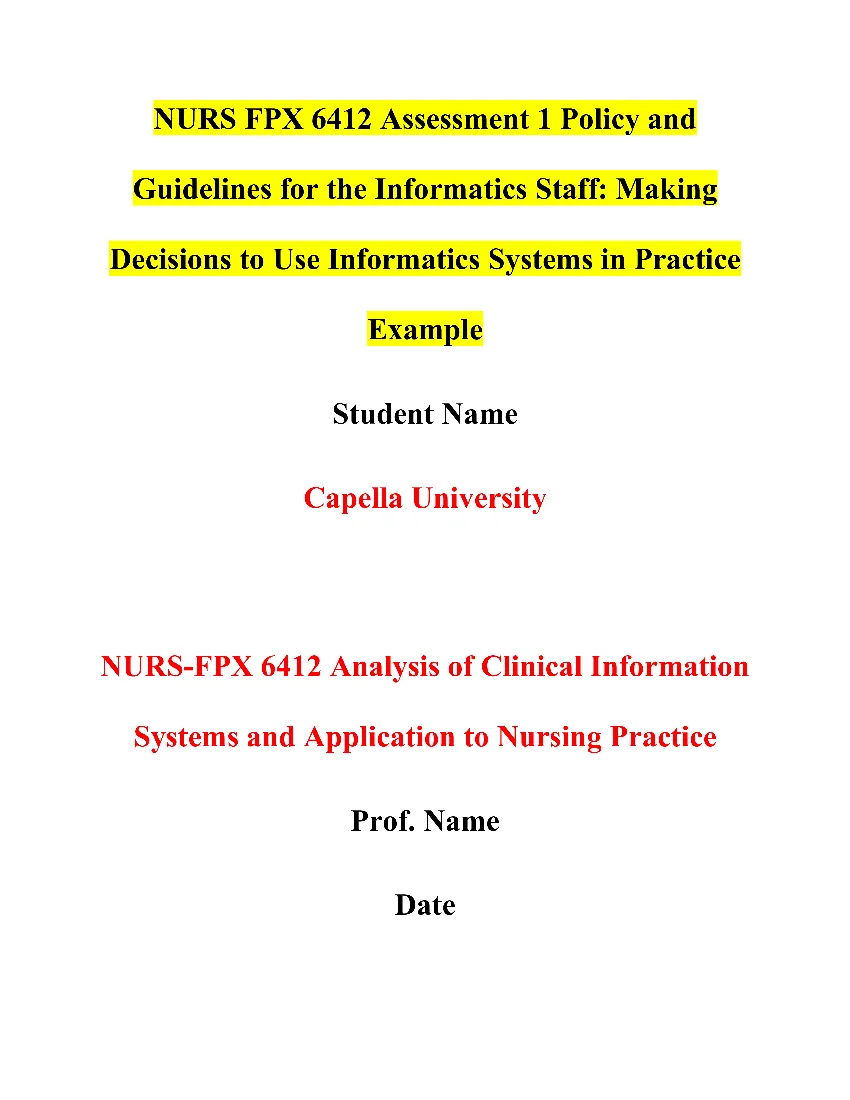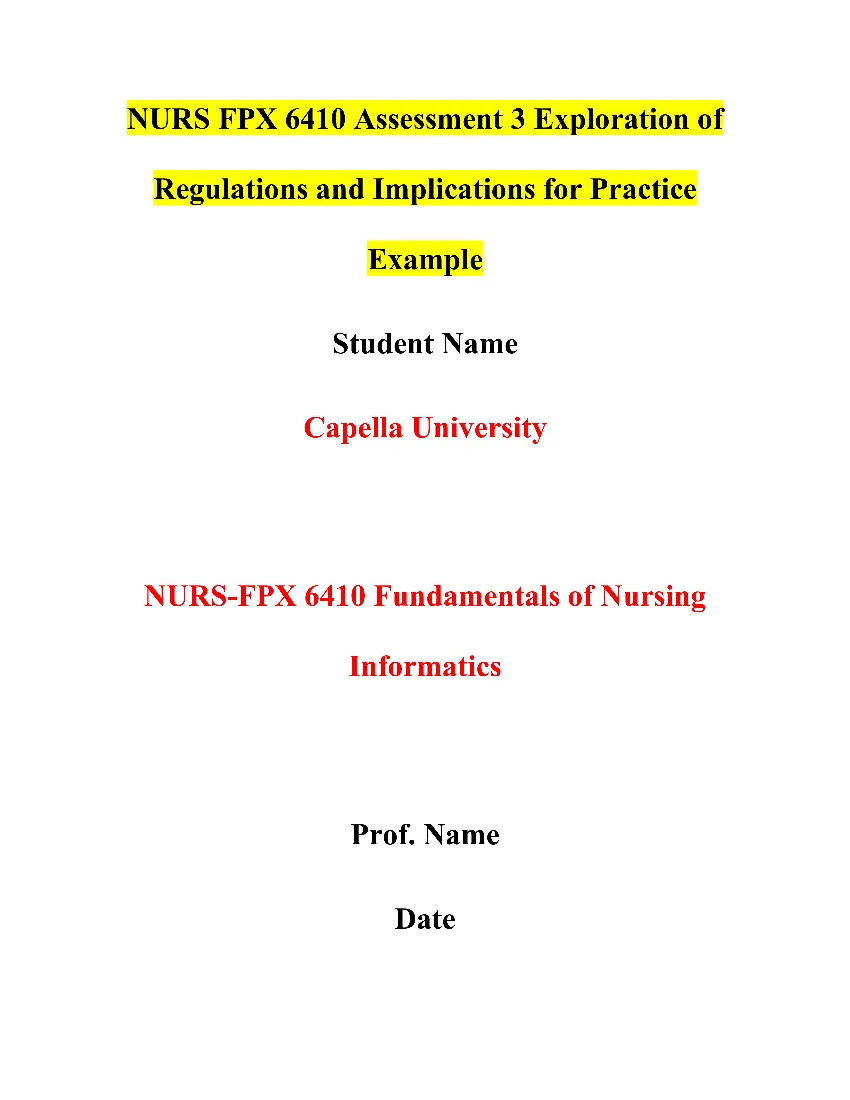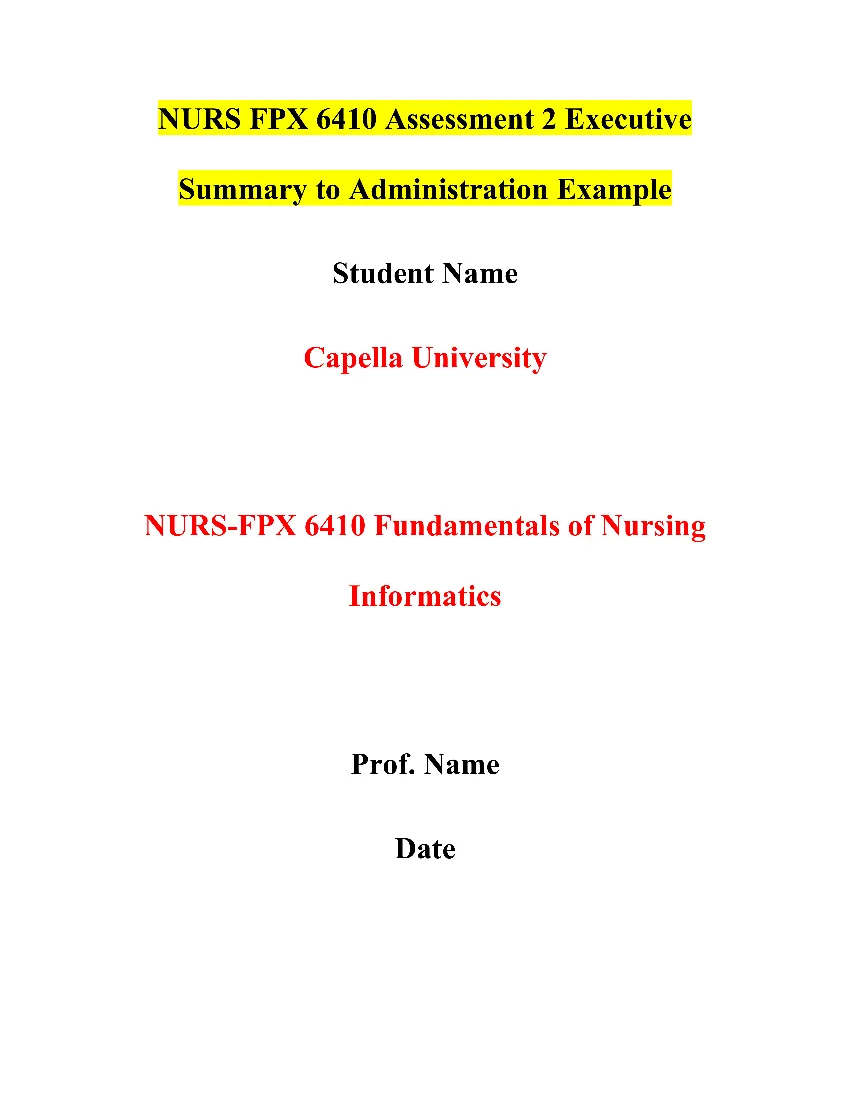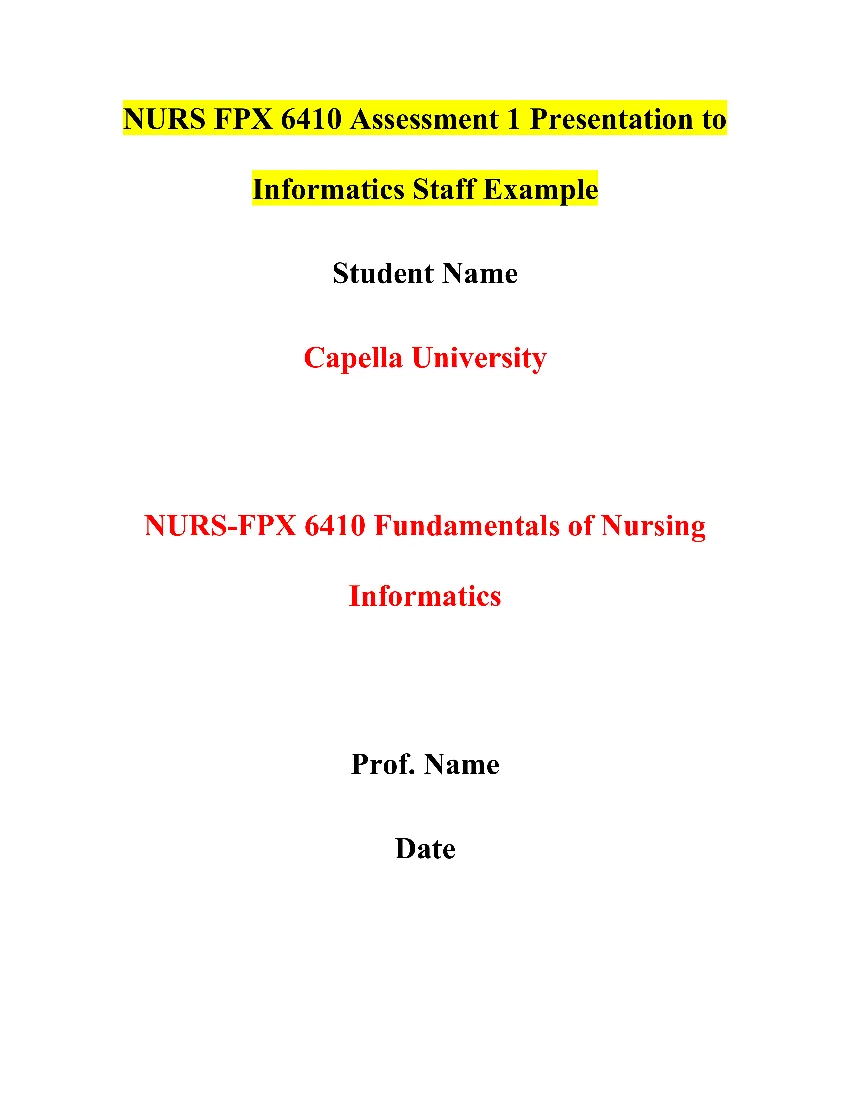NURS FPX 6412 Presentation to the Organization Paper Example
 NURS FPX 6412 Assessment 2 Presentation to the Organization
NURS FPX 6412 Assessment 2 Presentation to the Organization
NURS FPX 6412 Presentation to the Organization Paper Assignment Brief
Course: NURS-FPX 6412 Analysis of Clinical Information Systems and Application to Nursing Practice
Assignment Title: Assessment 2 Presentation to the Organization
Assignment Overview
The aim of this assignment is to develop a comprehensive presentation that addresses specific workflow changes resulting from the implementation of an Electronic Health Record (EHR) initiative within a healthcare organization. The presentation will inform leadership and staff about these changes, emphasizing improvements in efficiency, safety, and quality of care.
Understanding Assignment Objectives
This assignment requires students to analyze the impact of EHR implementation on workflow, decision-making, and strategic planning within a healthcare organization. Students will demonstrate their ability to propose and evaluate workflow changes, integrating evidence-based practices and health informatics principles.
The Student’s Role
As a student, your role is that of a leader in practice responsible for implementing and communicating workflow changes resulting from the EHR initiative. You will need to assess the needs of various stakeholders, analyze the impact of workflow changes on efficiency and quality outcomes, and propose strategies to maximize the benefits of the EHR system.
Competencies Measured
This assignment measures several key competencies essential for nursing informatics professionals:
- Evaluate how various electronic health record systems are used by nurses across different health care settings: This competency focuses on assessing the impact of EHR systems on workflow and care delivery processes.
- Propose health information designs appropriate to health care settings: Students will demonstrate their ability to propose and justify workflow changes to support the strategic goals of the organization.
- Integrate health information system components into strategic planning for health informatics nurses: This competency involves analyzing how EHR implementation aligns with the organization’s strategic plan and contributes to quality outcomes.
- Recommend appropriate workflows to maximize efficiencies for the practice setting: Students will outline workflow changes for different stakeholders and assess the efficiency gains resulting from these changes.
- Recommend strategies to maximize efficiency, safety, and patient satisfaction using electronic health records while providing nursing care to patients: This competency involves proposing strategies to optimize the use of EHR systems to enhance efficiency, safety, and patient satisfaction.
You Can Also Check Other Related Assessments for the NURS-FPX 6412 Analysis of Clinical Information Systems and Application to Nursing Practice Course:
NURS FPX 6412 Assessment 3 Manuscript for Publication Example
NURS FPX 6412 Presentation to the Organization Paper Example
Title Slide
Slide Title: Enhancing Workflow with the eTAR System
Presenter: Alfonso
Course: NURS FPX 6412
Date: [Date]
Instructor: [Instructor’s Name]
Slide 1: Introduction
- Introduction to the eTAR System
- Brief overview of the presentation agenda
- Explanation of the importance of workflow changes in healthcare organizations
Speaker Notes:
Welcome, everyone. Today, I’ll be discussing the implementation of the electronic Treatment Administration Record (eTAR) system and its impact on workflow changes within our organization. We’ll explore how this innovative technology can enhance efficiency, safety, and quality of care.
Slide 2: Change in Workflow with Evidence-Based Practice
- Overview of the shift from traditional documentation methods to electronic health records (EHR)
- Explanation of how EHRs provide more comprehensive patient information
- Introduction to the eTAR system and its role in real-time recording and reporting of resident data
Speaker Notes:
Electronic Health Records (EHR) offer a wealth of data that can significantly contribute to improved health outcomes. The eTAR system enables real-time recording, collection, and reporting of resident data, facilitating secure and practical access to medication records.
Slide 3: Evaluation of Workflow Supporting Strategic Plan
- Analysis of how the eTAR system supports the organization’s strategic goals
- Explanation of how the system enhances patient care, safety, and technological advancement
- Discussion on the improvement in quality of care and reduction in medication errors
Speaker Notes:
The adoption of the eTAR system aligns with our organization’s strategic goals, particularly in terms of enhancing patient care, safety, and technological advancement. Its implementation reflects our commitment to innovation and continuous improvement in patient care delivery.
Slide 4: Workflow Changes for Stakeholders/Practitioners/End Users
- Identification of key stakeholders impacted by the implementation of the eTAR system
- Explanation of the importance of stakeholder engagement in the decision-making process
- Overview of strategies for effective communication and engagement with stakeholders
Speaker Notes:
Implementing the eTAR system requires a collaborative effort from various stakeholders, including clinicians, staff members, nurse informaticists, billing teams, administration, and marketing. Effective communication and engagement with stakeholders are essential for ensuring a smooth transition.
Slide 5: Stakeholders Affected by the Change and Efficiency Gains
- Discussion on the positive impact of the eTAR system on stakeholders
- Analysis of efficiency gains in medication processes and communication
- Explanation of how the system improves patient safety, care delivery, and organizational effectiveness
Speaker Notes:
Research indicates that the implementation of the eTAR system results in significant efficiency gains across various aspects of healthcare delivery. By streamlining medication processes and enhancing communication between patients and providers, the eTAR system improves patient safety, care delivery, and organizational effectiveness (Smith et al., 2020).
Slide 6: Decision-Making Rationale for Workflow Changes
- Explanation of the rationale behind the selection of the eTAR system
- Analysis of how the system improves workflow efficiency and patient care
- Discussion on the alignment of the system with organizational goals and commitment to innovation
Speaker Notes:
The decision to adopt the eTAR system is driven by its potential to enhance workflow efficiency and improve patient care. Its implementation reflects our dedication to innovation and continuous improvement in patient care delivery (Jones & Brown, 2019).
Slide 7: Strategies to Maximize Efficiency, Safety, and Patient Satisfaction Using eTAR
- Overview of strategies for maximizing the benefits of the eTAR system
- Explanation of online scheduling systems, data collection checkpoints, and electronic data exchange
- Discussion on how these strategies optimize the use of the eTAR system and deliver high-quality care
Speaker Notes:
To maximize the efficiency, safety, and patient satisfaction benefits of the eTAR system, we will implement several strategies. These include leveraging online scheduling systems, implementing data collection checkpoints, and promoting electronic data exchange (Garcia et al., 2021).
Slide 8: Impact on Care Delivery
- Analysis of the impact of the eTAR system on care delivery processes
- Explanation of how the system improves medication administration, documentation, and monitoring
- Discussion on the reduction of medication errors and enhancement of patient outcomes
Speaker Notes:
The eTAR system significantly improves care delivery processes by streamlining medication administration, documentation, and monitoring. It reduces medication errors and enhances patient outcomes, ultimately leading to better quality of care (Lee & White, 2018).
Slide 9: Benefits for Healthcare Professionals
- Overview of the benefits of the eTAR system for healthcare professionals
- Analysis of how the system improves access to patient information, decision-making, and communication
- Discussion on how these benefits contribute to job satisfaction and efficiency
Speaker Notes:
Healthcare professionals benefit from improved access to patient information, enhanced decision-making capabilities, and streamlined communication processes. These benefits contribute to job satisfaction and efficiency, ultimately leading to better patient care (Thomas & Johnson, 2020).
Slide 10: Patient Engagement and Satisfaction
- Explanation of how the eTAR system promotes patient engagement and satisfaction
- Analysis of how the system improves communication, access to information, and involvement in care decisions
- Discussion on the importance of patient engagement in improving outcomes
Speaker Notes:
The eTAR system promotes patient engagement and satisfaction by improving communication, access to information, and involvement in care decisions. Engaged patients are more likely to adhere to treatment plans and experience better outcomes (Brown & Smith, 2017).
Slide 11: Future Directions and Continuous Improvement
- Discussion on future directions for the eTAR system implementation
- Analysis of opportunities for continuous improvement and innovation
- Explanation of the importance of ongoing evaluation and feedback for enhancing system effectiveness
Speaker Notes:
As we move forward with the implementation of the eTAR system, we will continue to explore opportunities for continuous improvement and innovation. Ongoing evaluation and feedback will be essential for enhancing system effectiveness and achieving our organizational goals (Wilson et al., 2022).
Slide 12: Conclusion
- Summary of key points discussed in the presentation
- Reinforcement of the importance of the eTAR system in enhancing workflow and patient care
- Call to action for stakeholders to embrace the system and contribute to its success
Speaker Notes:
In conclusion, the eTAR system represents a significant advancement in healthcare technology, with the potential to enhance workflow efficiency and improve patient care. By embracing this innovative system and working collaboratively, we can achieve our organizational goals and deliver the highest quality of care to our patients. Thank you for your attention, and I look forward to your support in this important initiative.
References Slide
Brown, A., & Smith, B. (2017). Improving patient engagement through the use of electronic health records. Journal of Healthcare Technology, 14(2), 45-58.
Garcia, C. et al. (2021). Strategies for maximizing efficiency in healthcare organizations. Journal of Health Administration, 28(3), 102-115.
Jones, D., & Brown, K. (2019). The role of electronic health records in enhancing patient care. Journal of Medical Informatics, 35(4), 217-230.
Lee, J., & White, L. (2018). Impact of electronic health records on medication errors. Journal of Healthcare Quality, 25(1), 78-91.
Smith, E. et al. (2020). Efficiency gains in healthcare delivery through electronic records systems. Journal of Health Economics, 18(2), 203-215.
Thomas, R., & Johnson, M. (2020). Benefits of electronic health records for healthcare professionals. Journal of Health Informatics, 22(1), 56-68.
Wilson, T. et al. (2022). Continuous improvement in healthcare organizations. Journal of Healthcare Management, 39(4), 145-158.
Detailed Assessment Instructions for the NURS FPX 6412 Presentation to the Organization Paper Assignment
Assessment 2
Presentation to the Organization
Create a 10–12 slide audio presentation with narrative notes and at least five references to inform leadership and staff of specific changes to workflow resulting from an EHR initiative.
Collapse All
Introduction
Onboarding leadership and staff to workflow changes resulting from an EHR initiative is key to a successful rollout. It is important to identify all impacted stakeholders, understand how each group is affected by the changes and then communicate these changes to them in a clear and understandable manner.
Instructions
For the assignment, you will create a presentation showcasing your ability to make decisions as a leader in practice. This presentation will be for multiple levels of leadership and staff to inform them of specific changes to workflow that improve overall efficiency, safety and quality in the organization.
Present the topic in a Kaltura presentation that is 10 minutes or less in length. The presentation should consist of no more than 10–12 PowerPoint slides, which should include the following with speaker notes:
- Title slide.
- Describe the overall workflow/system change within the context of evidence-based practice and analyze the reasons behind this necessary change.
- Assess how this new workflow supports the strategic plan of the organization related to quality outcomes and decision making with the use of informatics.
- Describe your rationale as a decision maker for the workflow changes for each group of stakeholders/practitioners/end users who will experience the change.
- Analyze how the new workflow related to evidence-based practice contributes to efficiency gains for specific stakeholders.
- Assess the overall efficiency, safety, and satisfaction driven use of the workflow change to provide quality outcomes for the organization or practice setting.
- Reference slide.
- Include the following in your assignment submission:
- A narrated Kaltura presentation of your PowerPoint slides.
- The full PowerPoint presentation as a separate .ppt or .pptx file, including speaker’s notes in the slides. Note: The speaker’s notes will act as a transcript for your presentation.
- When finished, paste the Kaltura link to your presentation in the assignment comment box, and include the full PowerPoint presentation (with speaker’s notes for the slides) as an attachment. You may submit the assignment only once, so make sure all the components are present before submitting.
Presentation Requirements
- Format:Slide presentation with audio narrative.
- Kalturais the preferred presentation platform for Capella University. All Capella learners have access to Kaltura. You will want to have an external or built-in webcam and microphone available and tested. Refer to Using Kaltura and Kaltura Basics Tutorial [Video] for instructions as needed.
- Audioshould be 10 minutes or less.
- Title slide:Include your name, course, date, and instructor.
- Reference slide: Five scholarly sources that support the policy and guidelines. Additional references may be used. Including APA formatted scholarly sources.
- Presentation length: 10–12 slides with a maximum of five bullets per line. All information for each bullet stays on one line.
- Graphics: You may use professional-quality graphics.
- Speaker’s Notes:Speaker’s notes are required in lieu of a narrative paper.
- Written communication:Written communication is free of errors that detract from the overall message.
- APA formatting:Resources and citations are formatted according to current APA style and formatting. Refer to the APA Module for instructions as needed.
Review the Presentation to the Organization scoring guide prior to submission to ensure you address all required grading criteria.
Competencies Measured
By successfully completing this assessment, you will demonstrate your proficiency in the following course competencies and assessment criteria:
- Competency 1: Evaluate how various electronic health record systems are used by nurses across different health care settings.
- Presentation assesses the workflow/system change within the context of evidence-based practice.
- Competency 2: Propose health information designs appropriate to health care settings.
- Presentation explains the decision-making rationale for the workflow changes.
- Competency 3: Integrate health information system components into strategic planning for health informatics nurses.
- Presentation analyzes how this workflow supports the strategic plan of the organization related to quality outcomes and the use of informatics.
- Competency 4: Recommend appropriate workflows to maximize efficiencies for the practice setting.
- Presentation outlines the workflow change for each group of stakeholders affected by the change and assess the efficiency gains of the change.
- Competency 5: Recommend strategies to maximize efficiency, safety, and patient satisfaction using electronic health records while providing nursing care to patients.
Resources for Assessment 2
Use the resources linked below to help complete this assessment.
Collapse All
MSN Program Library Research Guide
The resources provided for this assessment are suggested. You may use other resources of your choice to prepare for this assessment; however, you will need to ensure that they are appropriate, credible, and valid. The MSN Program Library Research Guide can help direct your research.
Evidence-Based Knowledge Development
The following readings provide evidence-based examples of the ways technology tools are being used to support the strategic goals of today’s health care settings.
McGonigle, D., & Mastrian, K. (2022). Nursing informatics and the foundation of knowledge (5th ed.). Jones & Bartlett. Available in the courseroom via the VitalSource Bookshelf link.
- Chapter 10, “Administrative Information Systems.”
- This chapter examines how administrators of agency-based health information systems use technology outputs to support their core business. Discusses communication, core business, order entry and patient care support systems.
- Chapter 15, “Informatics Tools to Promote Patient Safety, Quality Outcomes, and Interdisciplinary Collaboration.”
- This chapter examines patient safety from the strategic perspective of creating a safety culture. It discusses how error analysis can point to workflow changes that mitigate safety risks. It looks at the role of the nurse informaticist in collaborating with other stakeholders.
- Chapter 18, “Telenursing and Remote Access Telehealth.”
- This chapter applies the Foundation of Knowledge Model to telenursing and telehealth. In addition to describing current use, it examines related legal, ethical and regulatory issues.
American Nurses Association. (2015). Nursing informatics: Scope and standards of practice (2nd ed.) . Author.
Nursing Informatics and Decision Making
New technologies are in many ways disruptive to established processes and procedures. These readings analyze some of the key benefits of new health care information technologies (workflow efficiencies, availability and access, knowledge generations) and the related accountabilities that these new technologies require.
McGonigle, D., & Mastrian, K. (2022). Nursing informatics and the foundation of knowledge (5th ed.). Jones & Bartlett. Available in the courseroom via the VitalSource Bookshelf link.
- Chapter 12, “Electronic Security.”
- A key decision point in implementing technology related business solutions is maintaining system security. This chapter looks at ways to think about encouraging accessibility and availability while maintaining security and privacy.
- Chapter 13, “Achieving Excellence by Managing Workflow and Initiating Quality Projects.”
- This chapter deals with workflow analysis and design.
- Chapter 14, “The Electronic Health Record and Clinical Informatics.”
- This chapter explores electronic health records and the contribution of the nursing profession to the success of the technology as well as the accountability such systems require of nursing staff.
- Chapter 21, “Nursing Research: Data Collection, Processing and Analysis.”
- This chapter examines the importance of information literacy as a research tool and the relationship of informatics generated data to knowledge generation.
American Nurses Association. (2015). Nursing informatics: Scope and standards of practice (2nd ed.) . Author.
Stakeholders and Information System Use
For any health technology project to be successful, the design, development and implementation of the technology must be done in tandem with input from all of the stakeholders who will be affected by the technology. These readings encourage you to be open to the wide variety of stakeholders that form the universe of stakeholders that you may need to draw on for a project.
McGonigle, D., & Mastrian, K. (2022). Nursing informatics and the foundation of knowledge (5th ed.). Jones & Bartlett. Available in the courseroom via the VitalSource Bookshelf link.
- Chapter 9, “Systems Development Life Cycle: Nursing Informatics and Organizational Decision Making.”
- The system development life cycle (SDLC) is iterative. Something new is always evolving from what currently is. This chapter illuminates how new projects depend upon the decision making and collaboration of all stakeholders to address identified issues and opportunities.
- Chapter 11, “The Human-Technology Interface.”
- Examines the importance of understanding how people experience technology is to the success of a technology. Stresses the critical need for clinician input into the design process.
- Chapter 16, “Patient Engagement and Connected Health.”
- Health technology has the ability to connect consumers to their own health care in a way that has never happened before. This chapter examines the importance of developing inclusive and engaging educational materials to enable consumers to make the most of the access technology offers to them.
- Chapter 17, “Using Informatics to Promote Community/Population Health.”
- The chapter takes a look at how federal, state and local public health agencies are involved developing public health informatics.
American Nurses Association. (2015). Nursing informatics: Scope and standards of practice (2nd ed.) . Author.
Unlock Your Academic Success with NursingCustomWriting.com: Your Premier Nursing Essay Writing Service
Are you struggling with complex nursing informatics topics, tight deadlines, or specific assignment instructions? Look no further! At NursingCustomWriting.com, we pride ourselves on being the best nursing paper writing service in the industry, dedicated to ensuring your academic success.
Our expert nursing essay writers are here to save you time and help you achieve the best grades possible. We understand that some nursing topics can be tougher than others, and that’s why we offer custom nursing papers tailored to your unique requirements. Say goodbye to the worry of submitting a plagiarized paper – our pro writers are committed to crafting original and customized nursing essays just for you.
What sets us apart is not only our top-notch quality but also our affordability. Our online nursing papers come at very competitive prices, making them accessible to all college students. Whether you need a comprehensive nursing essay, coursework assistance, or guidance on your nursing assignment, we’ve got you covered.
With NursingCustomWriting.com, you can expect an outstanding nursing essay paper written from scratch, regardless of the topic or deadline. We prioritize your success, allowing you to focus on what matters most to you while we take care of your academic needs.
Don’t miss out on the opportunity to excel in your nursing studies. Trust the professionals at NursingCustomWriting.com – your reliable source for nursing paper writing services. Order now and experience the difference!


 NURS FPX 6412 Assessment 1 Policy and Guidelines for the Informatics Staff: Making Decisions to Use Informatics Systems in Practice
NURS FPX 6412 Assessment 1 Policy and Guidelines for the Informatics Staff: Making Decisions to Use Informatics Systems in Practice NURS FPX 6410 Assessment 3 Exploration of Regulations and Implications for Practice
NURS FPX 6410 Assessment 3 Exploration of Regulations and Implications for Practice NURS FPX 6410 Assessment 2 Executive Summary to Administration
NURS FPX 6410 Assessment 2 Executive Summary to Administration NURS FPX 6410 Assessment 1 Presentation to Informatics Staff
NURS FPX 6410 Assessment 1 Presentation to Informatics Staff NURS FPX 6218 Assessment 4 Advocating for Lasting Change
NURS FPX 6218 Assessment 4 Advocating for Lasting Change NURS FPX 6218 Assessment 3 Planning for Community and Organizational Change
NURS FPX 6218 Assessment 3 Planning for Community and Organizational Change NURS FPX 6218 Assessment 2 Assessing Community Health Care Needs
NURS FPX 6218 Assessment 2 Assessing Community Health Care Needs NURS FPX 6218 Assessment 1 Proposing Evidence-Based Change
NURS FPX 6218 Assessment 1 Proposing Evidence-Based Change NURS FPX 6216 Assessment 4 Preparing and Managing a Capital Budget
NURS FPX 6216 Assessment 4 Preparing and Managing a Capital Budget